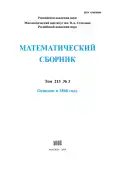Том 215, № 3 (2024)
Об одном свойстве системы Радемахера и $\Lambda(2)$-пространств
Аннотация
Замкнутая линейная оболочка функций Радемахера в пространстве $L^2[0,1]$ содержит функции со сколь угодно большим распределением при условии, что его отношение к распределению стандартной нормальной величины стремится к нулю. Аналогичный результат получен также для некоторых классов $\Lambda(2)$-пространств.Библиография: 18 названий.
 3-20
3-20


О единственности рядов по общей системе Франклина
Аннотация
Доказаны некоторые теоремы единственности для рядов по общей системе Франклина. В частности, для рядов по классической системеФранклина она будет звучать следующим образом: если частичные суммы $S_{n_i}(x)=\sum_{k=0}^{n_i}a_kf_k(x)$ ряда Франклина $\sum_{k=0}^{\infty}a_kf_k(x)$ по мере сходятся к интегрируемой функции $f$ и $\sup_i|S_{n_i}(x)|<\infty$, когда $x\notin B$, где $B$ – некоторое счетное множество и $\sup_i(n_i/n_{i-1})<\infty$, то этот ряд является рядом Фурье–Франклина функции $f$.Библиография: 29 названий.
 21-36
21-36


О кванторной версии модальной логики Белнапа–Данна
Аннотация
Разрабатывается кванторная версия пропозициональной модальной логики $\mathsf{BK}$ из статьи С. П. Одинцова и Х. Вансинга, в основе которой лежит (немодальная) система Белнапа–Данна; обозначим эту версию через $\mathsf{QBK}$. Сначала с помощью метода канонических моделей докажем, что $\mathsf{QBK}$, как и некоторые важные ее расширения, сильно полна относительно подходящей семантики возможных миров. Затем определим трансляции (в духе Гёделя–МакКинси–Тарского), точно вкладывающие кванторные версии конструктивных логик Нельсона в подходящие расширения $\mathsf{QBK}$. В заключение обсудим интерполяционные свойства для $\mathsf{QBK}$-расширений.Библиография: 21 название.
 37-69
37-69


Распределение нулей функций экспоненциального роста
Аннотация
Для систем уравнений с бесконечным числом корней иногда удается получить теоремы типа Кушниренко–Бернштейна–Хованского, заменяя вычисление числа корней на вычисление их асимптотической плотности. Мы рассматриваем системы целых функций экспоненциального роста в пространстве $\mathbb C^n$ и вычисляем асимптотику усредненного распределения корней в терминах геометрии выпуклых тел, расположенных в комплексном векторном пространстве.Библиография: 11 названий.
 70-79
70-79


Локализация оконных функций двойственных и жестких фреймов Габора, порожденных функцией Гаусса
Аннотация
Рассматриваются фреймы Габора, порожденные функцией Гаусса. С помощью констант неопределенности оценивается локализация функций двойственных фреймов в зависимости от соотношения параметров частотно-временного окна и степени переполненности. Общий вывод таков: при увеличении диспропорции окна локализация быстро ухудшается. С другой стороны, чем более переопределена исходная система функций, тем лучше локализованы функции двойственного фрейма. Для жесткого фрейма локализация при одном и том же наборе параметров существенно лучше, чем для двойственного фрейма. Рассматриваемая задача тесно связана с задачей интерполяции по равномерным сдвигам функции Гаусса. Построение узловой функции при интерполяции и функции окна двойственного фрейма осуществляется с помощью одних и тех же коэффициентов. Эти коэффициенты играют важную роль и при выводе формул для констант неопределенности. Поэтому в работе изучаются их свойства, связанные со знакочередуемостью и монотонностью убывания по модулю.Библиография: 38 названий.
 80-99
80-99


О восстановлении аналитических функций, точном на подпространствах целых функций
Аннотация
Построены семейства оптимальных методов восстановления аналитических в полосе функций и их производных по неточно заданному следу преобразования Фурье этих функций на вещественной оси. При этом от методов дополнительно требуется, чтобы они были точны на подпространствах целых функций.Библиография: 12 названий.
 100-118
100-118


О локальном устройстве выпуклых поверхностей
Аннотация
Рассмотрим точку на поверхности выпуклого тела и опорную плоскость к телу в этой точке. Проведем плоскость, параллельную данной опорной плоскости и отсекающую некоторую часть поверхности. Мы изучаем предельное поведение отсеченной части поверхности, когда секущая плоскость приближается к заданной точке. Более точно, изучается предельное поведение подходящим образом нормированной поверхностной меры в $S^2$, порожденной этой частью поверхности. Рассматриваются случаи, когда точка является регулярной и когда она особая: коническая или ребристая. Опорная плоскость может быть по-разному расположена по отношению к касательному конусу в данной точке: может пересекаться с конусом по вершине, прямой (если точка является особой ребристой), плоскому углу (который может вырождаться в луч или полуплоскость) или по плоскости (если точка регулярная и соответственно конус вырождается в полупространство). В случае пересечения по лучу плоскость может касаться конуса (односторонним или двусторонним образом) или же нет.Оказывается, предельное поведение меры может быть разным. В случае пересечения опорной плоскостью конуса по вершине или в случае (одностороннего или двустороннего) касания слабый предел всегда существует и однозначно определяется по плоскости и по конусу. В случае же пересечения по прямой или лучу при отсутствии касания предел может вообще не существовать. В последнем случае дана характеризация всех возможных слабых частичных пределов.Библиография: 13 названий.
 119-158
119-158











